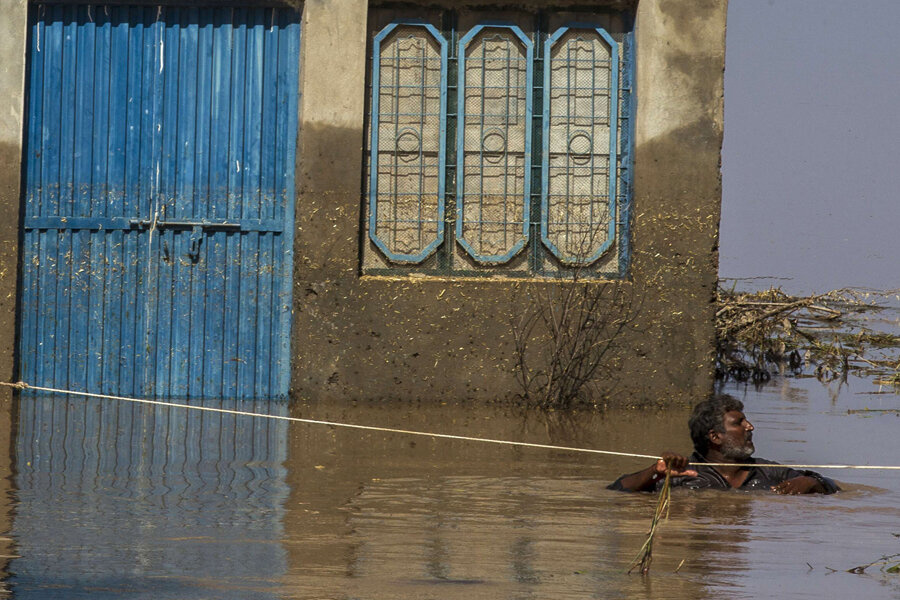Death toll from flooding in India and Pakistan reaches 400
Loading...
| Jhang, Pakistan
The death toll from floods in Pakistan and India reached 400 on Tuesday as armies in both countries scrambled to help the victims and authorities in Islamabad warned hundreds of thousands to be prepared to flee more flooding in the days ahead.
The flash floods, which began on Sept. 3, have put more than 1.5 million people in peril and left thousands of families homeless in the two neighboring states. Pakistan's minister for water and power, Khwaja Mohammad Asif, warned parliament that some 700,000 people have been told to leave their homes, which could be inundated in the next four days.
Pakistani and Indian troops have been using boats and helicopters to drop food supplies for stranded families and evacuate victims.
The floods have also triggered landslides in both sections of the divided Kashmir region, split between the two arch rivals, and caused much devastation in northern and eastern Pakistan.
The rains washed away houses, bridges, communication equipment and crops. Pakistani and Indian troops have evacuated more than 60,000 people to safer places, according to the statements from Indian and Pakistani armies.
In a bid to escape the floods, people in several cities, towns and villages waded through waist-deep water, as women carried household items and children on their shoulders as others dragged their livestock. On roadsides, families set up makeshift camps. Hundreds of others were stranded on the rooftops, waving for help to every passing helicopter.
On Tuesday, thousands awaited rescue teams and searched for missing loved ones.
On a road near the village of Jamia Abad in the eastern Pakistani district of Jhang, Naseem Akhtar, 41, said she had gone from one government office to another, trying to get someone to help her husband and other family members who had stayed back in their now-submerged village.
Last time she talked to her husband by phone was on Monday night, when he told her that they were sitting on the roof waiting to be rescued, she said.
"I went to the police, I tried to find a private boat, but nothing, there is no help," she said, adding she had been on the road for two days after taking her three children to a safer place.
Jhang's Deputy Commissioner Khurram Shahzad said that nearly 400,000 people in the district's urban areas had been put on alert to be ready to leave anytime.
So far, 205 have died in Pakistan while 200 perished in India, while nearly 700 people have been injured, officials said.
According to Ahmad Kamal, spokesman for Pakistan's National Disaster Management Authority, the floods were now moving toward Pakistan's south. Evacuations were already under way in several southern districts which could soon be inundated, said Kamal.
The Kashmir region in the northern Himalayas is divided between India and Pakistan and claimed by both. Two of the three wars the countries have fought since their independence from Britain in 1947 have been over control of Kashmir.
The Indian army late Monday airlifted communication equipment to restore telephone and mobile phone links that were snapped after large areas of Kashmir were submerged under flood water. Army engineers were working Tuesday to restore communication links, the Indian army said in a statement.
The relief packages the armies were dropping in the affected areas include blankets, food supplies, medicine and drinking water to thousands of people who had been moved to safer places.
Although the rains have stopped, the flood waters are likely to submerge hundreds of more villages. Pakistani authorities were bracing for worsening conditions as water levels in the Chenab and Indus rivers were rising, said Kamal, the disaster management officer.
Meanwhile, environmental experts in India said extensive deforestation of Kashmir's mountains has aggravated the damage due to the floods.
With the Himalayan hills in Kashmir stripped off their green cover, fast flowing streams were causing soil erosion and flash floods, said Krishnaswamy Srinivas of the Vasudha Foundation, a New Delhi-based environmental advocacy group.







